3D Printing Technologies in Rehabilitation Engineering
VerifiedAdded on 2023/06/12
|6
|3467
|396
AI Summary
This article explores the use of 3D printing, 3D scanning, and reverse engineering in rehabilitation engineering. It covers clinical applications, patient-tailored therapy, and directions for further research. The article emphasizes the need for interdisciplinary collaboration, dedicated education, clinical guidelines, and novel technologies and materials. The article is published in the Journal of Health Sciences and is available in open access.
Contribute Materials
Your contribution can guide someone’s learning journey. Share your
documents today.
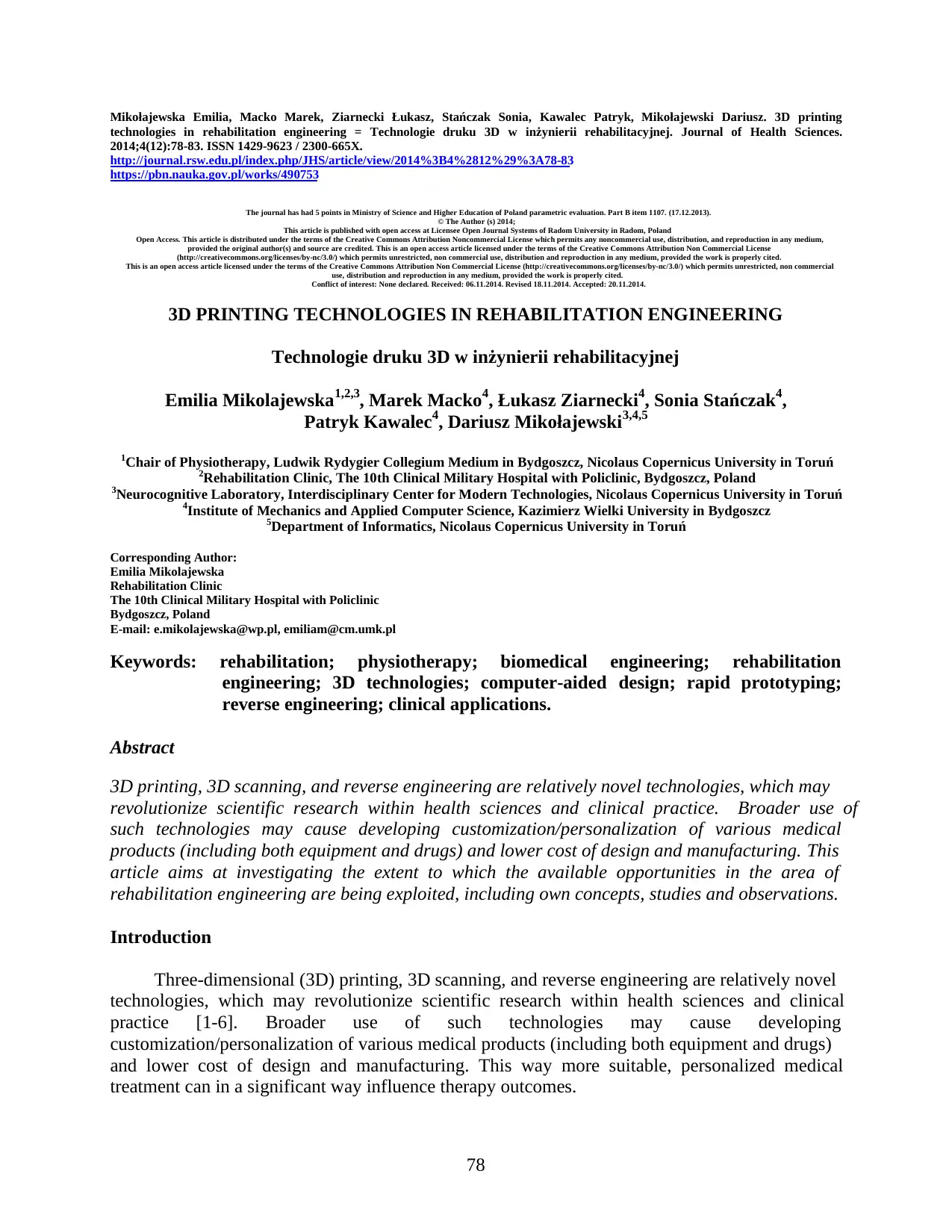
78
Mikołajewska Emilia, Macko Marek, Ziarnecki Łukasz, Stańczak Sonia, Kawalec Patryk, Mikołajewski Dariusz. 3D printing
technologies in rehabilitation engineering = Technologie druku 3D w inżynierii rehabilitacyjnej. Journal of Health Sciences.
2014;4(12):78-83. ISSN 1429-9623 / 2300-665X.
http://journal.rsw.edu.pl/index.php/JHS/article/view/2014%3B4%2812%29%3A78-83
https://pbn.nauka.gov.pl/works/490753
The journal has had 5 points in Ministry of Science and Higher Education of Poland parametric evaluation. Part B item 1107. (17.12.2013).
© The Author (s) 2014;
This article is published with open access at Licensee Open Journal Systems of Radom University in Radom, Poland
Open Access. This article is distributed under the terms of the Creative Commons Attribution Noncommercial License which permits any noncommercial use, distribution, and reproduction in any medium,
provided the original author(s) and source are credited. This is an open access article licensed under the terms of the Creative Commons Attribution Non Commercial License
(http://creativecommons.org/licenses/by-nc/3.0/) which permits unrestricted, non commercial use, distribution and reproduction in any medium, provided the work is properly cited.
This is an open access article licensed under the terms of the Creative Commons Attribution Non Commercial License (http://creativecommons.org/licenses/by-nc/3.0/) which permits unrestricted, non commercial
use, distribution and reproduction in any medium, provided the work is properly cited.
Conflict of interest: None declared. Received: 06.11.2014. Revised 18.11.2014. Accepted: 20.11.2014.
3D PRINTING TECHNOLOGIES IN REHABILITATION ENGINEERING
Technologie druku 3D w inżynierii rehabilitacyjnej
Emilia Mikolajewska1,2,3, Marek Macko4, Łukasz Ziarnecki4, Sonia Stańczak4,
Patryk Kawalec4, Dariusz Mikołajewski3,4,5
1Chair of Physiotherapy, Ludwik Rydygier Collegium Medium in Bydgoszcz, Nicolaus Copernicus University in Toruń
2Rehabilitation Clinic, The 10th Clinical Military Hospital with Policlinic, Bydgoszcz, Poland
3Neurocognitive Laboratory, Interdisciplinary Center for Modern Technologies, Nicolaus Copernicus University in Toruń
4Institute of Mechanics and Applied Computer Science, Kazimierz Wielki University in Bydgoszcz
5Department of Informatics, Nicolaus Copernicus University in Toruń
Corresponding Author:
Emilia Mikolajewska
Rehabilitation Clinic
The 10th Clinical Military Hospital with Policlinic
Bydgoszcz, Poland
E-mail: e.mikolajewska@wp.pl, emiliam@cm.umk.pl
Keywords: rehabilitation; physiotherapy; biomedical engineering; rehabilitation
engineering; 3D technologies; computer-aided design; rapid prototyping;
reverse engineering; clinical applications.
Abstract
3D printing, 3D scanning, and reverse engineering are relatively novel technologies, which may
revolutionize scientific research within health sciences and clinical practice. Broader use of
such technologies may cause developing customization/personalization of various medical
products (including both equipment and drugs) and lower cost of design and manufacturing. This
article aims at investigating the extent to which the available opportunities in the area of
rehabilitation engineering are being exploited, including own concepts, studies and observations.
Introduction
Three-dimensional (3D) printing, 3D scanning, and reverse engineering are relatively novel
technologies, which may revolutionize scientific research within health sciences and clinical
practice [1-6]. Broader use of such technologies may cause developing
customization/personalization of various medical products (including both equipment and drugs)
and lower cost of design and manufacturing. This way more suitable, personalized medical
treatment can in a significant way influence therapy outcomes.
Mikołajewska Emilia, Macko Marek, Ziarnecki Łukasz, Stańczak Sonia, Kawalec Patryk, Mikołajewski Dariusz. 3D printing
technologies in rehabilitation engineering = Technologie druku 3D w inżynierii rehabilitacyjnej. Journal of Health Sciences.
2014;4(12):78-83. ISSN 1429-9623 / 2300-665X.
http://journal.rsw.edu.pl/index.php/JHS/article/view/2014%3B4%2812%29%3A78-83
https://pbn.nauka.gov.pl/works/490753
The journal has had 5 points in Ministry of Science and Higher Education of Poland parametric evaluation. Part B item 1107. (17.12.2013).
© The Author (s) 2014;
This article is published with open access at Licensee Open Journal Systems of Radom University in Radom, Poland
Open Access. This article is distributed under the terms of the Creative Commons Attribution Noncommercial License which permits any noncommercial use, distribution, and reproduction in any medium,
provided the original author(s) and source are credited. This is an open access article licensed under the terms of the Creative Commons Attribution Non Commercial License
(http://creativecommons.org/licenses/by-nc/3.0/) which permits unrestricted, non commercial use, distribution and reproduction in any medium, provided the work is properly cited.
This is an open access article licensed under the terms of the Creative Commons Attribution Non Commercial License (http://creativecommons.org/licenses/by-nc/3.0/) which permits unrestricted, non commercial
use, distribution and reproduction in any medium, provided the work is properly cited.
Conflict of interest: None declared. Received: 06.11.2014. Revised 18.11.2014. Accepted: 20.11.2014.
3D PRINTING TECHNOLOGIES IN REHABILITATION ENGINEERING
Technologie druku 3D w inżynierii rehabilitacyjnej
Emilia Mikolajewska1,2,3, Marek Macko4, Łukasz Ziarnecki4, Sonia Stańczak4,
Patryk Kawalec4, Dariusz Mikołajewski3,4,5
1Chair of Physiotherapy, Ludwik Rydygier Collegium Medium in Bydgoszcz, Nicolaus Copernicus University in Toruń
2Rehabilitation Clinic, The 10th Clinical Military Hospital with Policlinic, Bydgoszcz, Poland
3Neurocognitive Laboratory, Interdisciplinary Center for Modern Technologies, Nicolaus Copernicus University in Toruń
4Institute of Mechanics and Applied Computer Science, Kazimierz Wielki University in Bydgoszcz
5Department of Informatics, Nicolaus Copernicus University in Toruń
Corresponding Author:
Emilia Mikolajewska
Rehabilitation Clinic
The 10th Clinical Military Hospital with Policlinic
Bydgoszcz, Poland
E-mail: e.mikolajewska@wp.pl, emiliam@cm.umk.pl
Keywords: rehabilitation; physiotherapy; biomedical engineering; rehabilitation
engineering; 3D technologies; computer-aided design; rapid prototyping;
reverse engineering; clinical applications.
Abstract
3D printing, 3D scanning, and reverse engineering are relatively novel technologies, which may
revolutionize scientific research within health sciences and clinical practice. Broader use of
such technologies may cause developing customization/personalization of various medical
products (including both equipment and drugs) and lower cost of design and manufacturing. This
article aims at investigating the extent to which the available opportunities in the area of
rehabilitation engineering are being exploited, including own concepts, studies and observations.
Introduction
Three-dimensional (3D) printing, 3D scanning, and reverse engineering are relatively novel
technologies, which may revolutionize scientific research within health sciences and clinical
practice [1-6]. Broader use of such technologies may cause developing
customization/personalization of various medical products (including both equipment and drugs)
and lower cost of design and manufacturing. This way more suitable, personalized medical
treatment can in a significant way influence therapy outcomes.
Secure Best Marks with AI Grader
Need help grading? Try our AI Grader for instant feedback on your assignments.
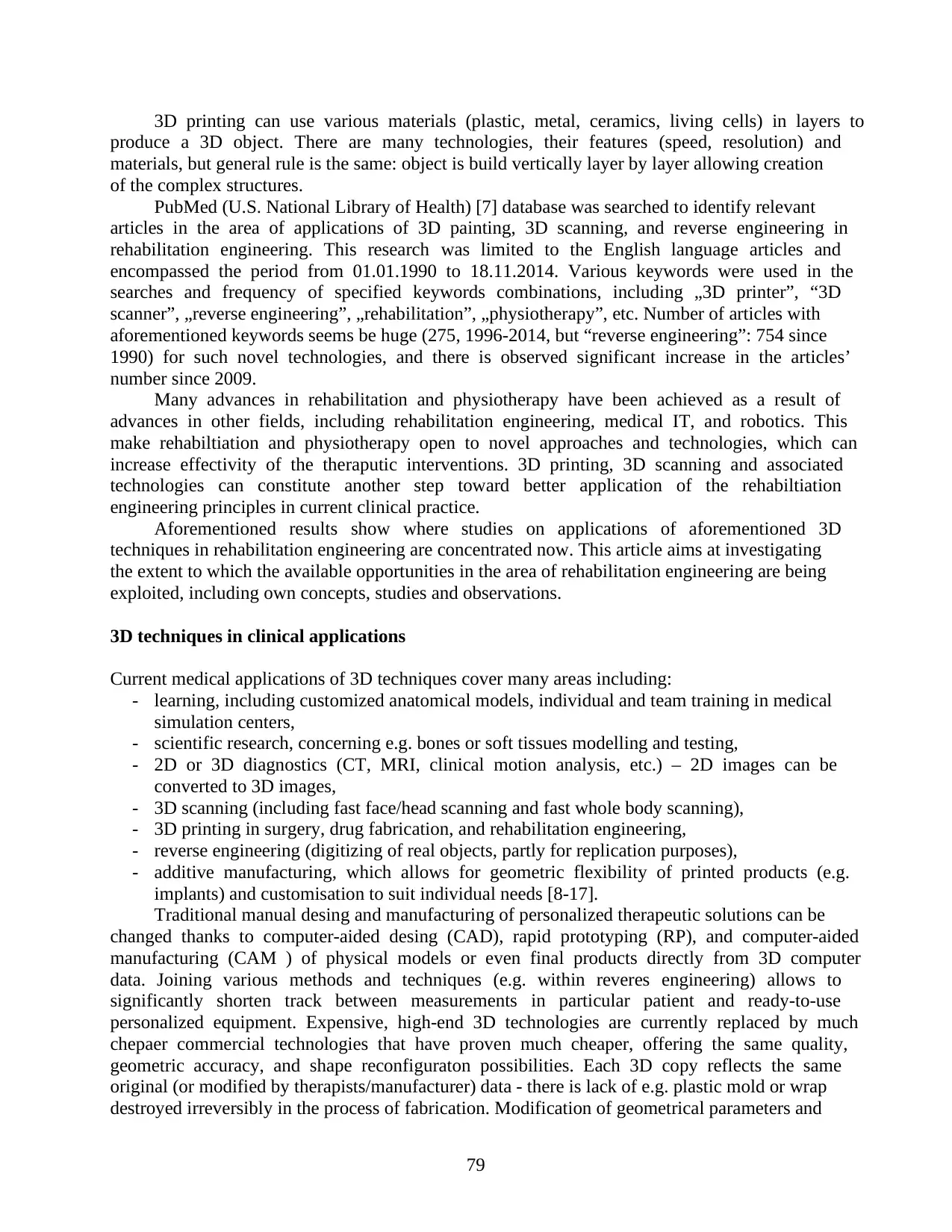
79
3D printing can use various materials (plastic, metal, ceramics, living cells) in layers to
produce a 3D object. There are many technologies, their features (speed, resolution) and
materials, but general rule is the same: object is build vertically layer by layer allowing creation
of the complex structures.
PubMed (U.S. National Library of Health) [7] database was searched to identify relevant
articles in the area of applications of 3D painting, 3D scanning, and reverse engineering in
rehabilitation engineering. This research was limited to the English language articles and
encompassed the period from 01.01.1990 to 18.11.2014. Various keywords were used in the
searches and frequency of specified keywords combinations, including „3D printer”, “3D
scanner”, „reverse engineering”, „rehabilitation”, „physiotherapy”, etc. Number of articles with
aforementioned keywords seems be huge (275, 1996-2014, but “reverse engineering”: 754 since
1990) for such novel technologies, and there is observed significant increase in the articles’
number since 2009.
Many advances in rehabilitation and physiotherapy have been achieved as a result of
advances in other fields, including rehabilitation engineering, medical IT, and robotics. This
make rehabiltiation and physiotherapy open to novel approaches and technologies, which can
increase effectivity of the theraputic interventions. 3D printing, 3D scanning and associated
technologies can constitute another step toward better application of the rehabiltiation
engineering principles in current clinical practice.
Aforementioned results show where studies on applications of aforementioned 3D
techniques in rehabilitation engineering are concentrated now. This article aims at investigating
the extent to which the available opportunities in the area of rehabilitation engineering are being
exploited, including own concepts, studies and observations.
3D techniques in clinical applications
Current medical applications of 3D techniques cover many areas including:
- learning, including customized anatomical models, individual and team training in medical
simulation centers,
- scientific research, concerning e.g. bones or soft tissues modelling and testing,
- 2D or 3D diagnostics (CT, MRI, clinical motion analysis, etc.) – 2D images can be
converted to 3D images,
- 3D scanning (including fast face/head scanning and fast whole body scanning),
- 3D printing in surgery, drug fabrication, and rehabilitation engineering,
- reverse engineering (digitizing of real objects, partly for replication purposes),
- additive manufacturing, which allows for geometric flexibility of printed products (e.g.
implants) and customisation to suit individual needs [8-17].
Traditional manual desing and manufacturing of personalized therapeutic solutions can be
changed thanks to computer-aided desing (CAD), rapid prototyping (RP), and computer-aided
manufacturing (CAM ) of physical models or even final products directly from 3D computer
data. Joining various methods and techniques (e.g. within reveres engineering) allows to
significantly shorten track between measurements in particular patient and ready-to-use
personalized equipment. Expensive, high-end 3D technologies are currently replaced by much
chepaer commercial technologies that have proven much cheaper, offering the same quality,
geometric accuracy, and shape reconfiguraton possibilities. Each 3D copy reflects the same
original (or modified by therapists/manufacturer) data - there is lack of e.g. plastic mold or wrap
destroyed irreversibly in the process of fabrication. Modification of geometrical parameters and
3D printing can use various materials (plastic, metal, ceramics, living cells) in layers to
produce a 3D object. There are many technologies, their features (speed, resolution) and
materials, but general rule is the same: object is build vertically layer by layer allowing creation
of the complex structures.
PubMed (U.S. National Library of Health) [7] database was searched to identify relevant
articles in the area of applications of 3D painting, 3D scanning, and reverse engineering in
rehabilitation engineering. This research was limited to the English language articles and
encompassed the period from 01.01.1990 to 18.11.2014. Various keywords were used in the
searches and frequency of specified keywords combinations, including „3D printer”, “3D
scanner”, „reverse engineering”, „rehabilitation”, „physiotherapy”, etc. Number of articles with
aforementioned keywords seems be huge (275, 1996-2014, but “reverse engineering”: 754 since
1990) for such novel technologies, and there is observed significant increase in the articles’
number since 2009.
Many advances in rehabilitation and physiotherapy have been achieved as a result of
advances in other fields, including rehabilitation engineering, medical IT, and robotics. This
make rehabiltiation and physiotherapy open to novel approaches and technologies, which can
increase effectivity of the theraputic interventions. 3D printing, 3D scanning and associated
technologies can constitute another step toward better application of the rehabiltiation
engineering principles in current clinical practice.
Aforementioned results show where studies on applications of aforementioned 3D
techniques in rehabilitation engineering are concentrated now. This article aims at investigating
the extent to which the available opportunities in the area of rehabilitation engineering are being
exploited, including own concepts, studies and observations.
3D techniques in clinical applications
Current medical applications of 3D techniques cover many areas including:
- learning, including customized anatomical models, individual and team training in medical
simulation centers,
- scientific research, concerning e.g. bones or soft tissues modelling and testing,
- 2D or 3D diagnostics (CT, MRI, clinical motion analysis, etc.) – 2D images can be
converted to 3D images,
- 3D scanning (including fast face/head scanning and fast whole body scanning),
- 3D printing in surgery, drug fabrication, and rehabilitation engineering,
- reverse engineering (digitizing of real objects, partly for replication purposes),
- additive manufacturing, which allows for geometric flexibility of printed products (e.g.
implants) and customisation to suit individual needs [8-17].
Traditional manual desing and manufacturing of personalized therapeutic solutions can be
changed thanks to computer-aided desing (CAD), rapid prototyping (RP), and computer-aided
manufacturing (CAM ) of physical models or even final products directly from 3D computer
data. Joining various methods and techniques (e.g. within reveres engineering) allows to
significantly shorten track between measurements in particular patient and ready-to-use
personalized equipment. Expensive, high-end 3D technologies are currently replaced by much
chepaer commercial technologies that have proven much cheaper, offering the same quality,
geometric accuracy, and shape reconfiguraton possibilities. Each 3D copy reflects the same
original (or modified by therapists/manufacturer) data - there is lack of e.g. plastic mold or wrap
destroyed irreversibly in the process of fabrication. Modification of geometrical parameters and
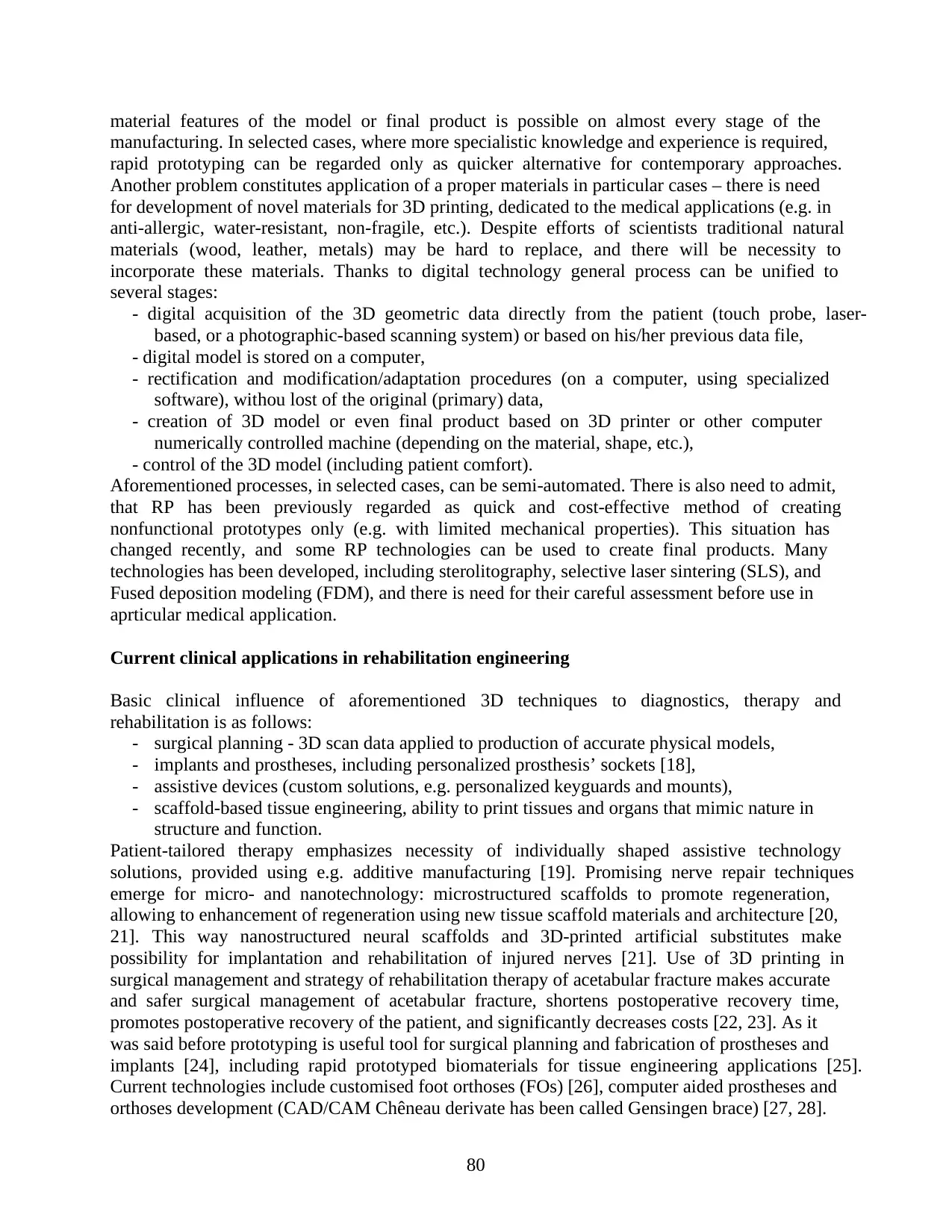
80
material features of the model or final product is possible on almost every stage of the
manufacturing. In selected cases, where more specialistic knowledge and experience is required,
rapid prototyping can be regarded only as quicker alternative for contemporary approaches.
Another problem constitutes application of a proper materials in particular cases – there is need
for development of novel materials for 3D printing, dedicated to the medical applications (e.g. in
anti-allergic, water-resistant, non-fragile, etc.). Despite efforts of scientists traditional natural
materials (wood, leather, metals) may be hard to replace, and there will be necessity to
incorporate these materials. Thanks to digital technology general process can be unified to
several stages:
- digital acquisition of the 3D geometric data directly from the patient (touch probe, laser-
based, or a photographic-based scanning system) or based on his/her previous data file,
- digital model is stored on a computer,
- rectification and modification/adaptation procedures (on a computer, using specialized
software), withou lost of the original (primary) data,
- creation of 3D model or even final product based on 3D printer or other computer
numerically controlled machine (depending on the material, shape, etc.),
- control of the 3D model (including patient comfort).
Aforementioned processes, in selected cases, can be semi-automated. There is also need to admit,
that RP has been previously regarded as quick and cost-effective method of creating
nonfunctional prototypes only (e.g. with limited mechanical properties). This situation has
changed recently, and some RP technologies can be used to create final products. Many
technologies has been developed, including sterolitography, selective laser sintering (SLS), and
Fused deposition modeling (FDM), and there is need for their careful assessment before use in
aprticular medical application.
Current clinical applications in rehabilitation engineering
Basic clinical influence of aforementioned 3D techniques to diagnostics, therapy and
rehabilitation is as follows:
- surgical planning - 3D scan data applied to production of accurate physical models,
- implants and prostheses, including personalized prosthesis’ sockets [18],
- assistive devices (custom solutions, e.g. personalized keyguards and mounts),
- scaffold-based tissue engineering, ability to print tissues and organs that mimic nature in
structure and function.
Patient-tailored therapy emphasizes necessity of individually shaped assistive technology
solutions, provided using e.g. additive manufacturing [19]. Promising nerve repair techniques
emerge for micro- and nanotechnology: microstructured scaffolds to promote regeneration,
allowing to enhancement of regeneration using new tissue scaffold materials and architecture [20,
21]. This way nanostructured neural scaffolds and 3D-printed artificial substitutes make
possibility for implantation and rehabilitation of injured nerves [21]. Use of 3D printing in
surgical management and strategy of rehabilitation therapy of acetabular fracture makes accurate
and safer surgical management of acetabular fracture, shortens postoperative recovery time,
promotes postoperative recovery of the patient, and significantly decreases costs [22, 23]. As it
was said before prototyping is useful tool for surgical planning and fabrication of prostheses and
implants [24], including rapid prototyped biomaterials for tissue engineering applications [25].
Current technologies include customised foot orthoses (FOs) [26], computer aided prostheses and
orthoses development (CAD/CAM Chêneau derivate has been called Gensingen brace) [27, 28].
material features of the model or final product is possible on almost every stage of the
manufacturing. In selected cases, where more specialistic knowledge and experience is required,
rapid prototyping can be regarded only as quicker alternative for contemporary approaches.
Another problem constitutes application of a proper materials in particular cases – there is need
for development of novel materials for 3D printing, dedicated to the medical applications (e.g. in
anti-allergic, water-resistant, non-fragile, etc.). Despite efforts of scientists traditional natural
materials (wood, leather, metals) may be hard to replace, and there will be necessity to
incorporate these materials. Thanks to digital technology general process can be unified to
several stages:
- digital acquisition of the 3D geometric data directly from the patient (touch probe, laser-
based, or a photographic-based scanning system) or based on his/her previous data file,
- digital model is stored on a computer,
- rectification and modification/adaptation procedures (on a computer, using specialized
software), withou lost of the original (primary) data,
- creation of 3D model or even final product based on 3D printer or other computer
numerically controlled machine (depending on the material, shape, etc.),
- control of the 3D model (including patient comfort).
Aforementioned processes, in selected cases, can be semi-automated. There is also need to admit,
that RP has been previously regarded as quick and cost-effective method of creating
nonfunctional prototypes only (e.g. with limited mechanical properties). This situation has
changed recently, and some RP technologies can be used to create final products. Many
technologies has been developed, including sterolitography, selective laser sintering (SLS), and
Fused deposition modeling (FDM), and there is need for their careful assessment before use in
aprticular medical application.
Current clinical applications in rehabilitation engineering
Basic clinical influence of aforementioned 3D techniques to diagnostics, therapy and
rehabilitation is as follows:
- surgical planning - 3D scan data applied to production of accurate physical models,
- implants and prostheses, including personalized prosthesis’ sockets [18],
- assistive devices (custom solutions, e.g. personalized keyguards and mounts),
- scaffold-based tissue engineering, ability to print tissues and organs that mimic nature in
structure and function.
Patient-tailored therapy emphasizes necessity of individually shaped assistive technology
solutions, provided using e.g. additive manufacturing [19]. Promising nerve repair techniques
emerge for micro- and nanotechnology: microstructured scaffolds to promote regeneration,
allowing to enhancement of regeneration using new tissue scaffold materials and architecture [20,
21]. This way nanostructured neural scaffolds and 3D-printed artificial substitutes make
possibility for implantation and rehabilitation of injured nerves [21]. Use of 3D printing in
surgical management and strategy of rehabilitation therapy of acetabular fracture makes accurate
and safer surgical management of acetabular fracture, shortens postoperative recovery time,
promotes postoperative recovery of the patient, and significantly decreases costs [22, 23]. As it
was said before prototyping is useful tool for surgical planning and fabrication of prostheses and
implants [24], including rapid prototyped biomaterials for tissue engineering applications [25].
Current technologies include customised foot orthoses (FOs) [26], computer aided prostheses and
orthoses development (CAD/CAM Chêneau derivate has been called Gensingen brace) [27, 28].
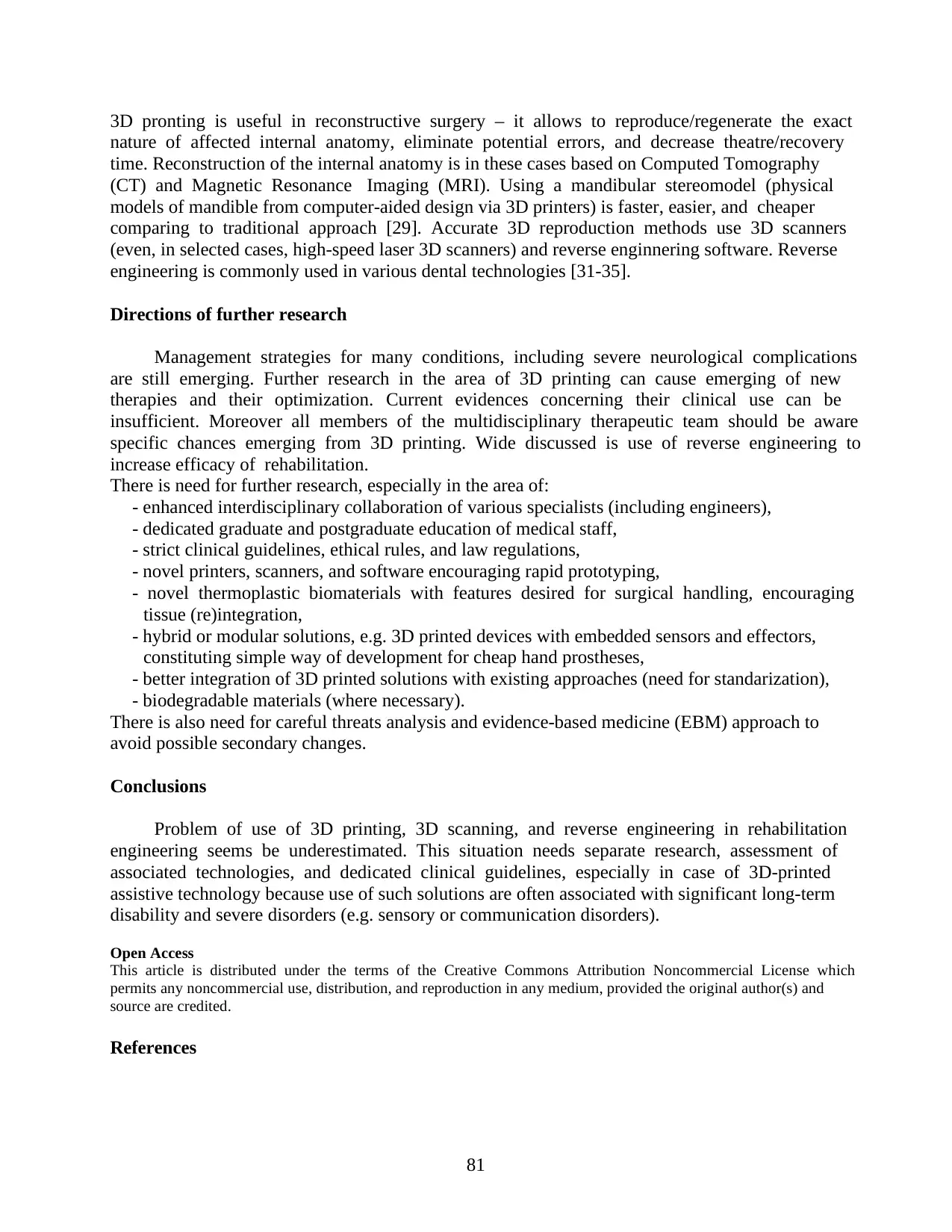
81
3D pronting is useful in reconstructive surgery – it allows to reproduce/regenerate the exact
nature of affected internal anatomy, eliminate potential errors, and decrease theatre/recovery
time. Reconstruction of the internal anatomy is in these cases based on Computed Tomography
(CT) and Magnetic Resonance Imaging (MRI). Using a mandibular stereomodel (physical
models of mandible from computer-aided design via 3D printers) is faster, easier, and cheaper
comparing to traditional approach [29]. Accurate 3D reproduction methods use 3D scanners
(even, in selected cases, high-speed laser 3D scanners) and reverse enginnering software. Reverse
engineering is commonly used in various dental technologies [31-35].
Directions of further research
Management strategies for many conditions, including severe neurological complications
are still emerging. Further research in the area of 3D printing can cause emerging of new
therapies and their optimization. Current evidences concerning their clinical use can be
insufficient. Moreover all members of the multidisciplinary therapeutic team should be aware
specific chances emerging from 3D printing. Wide discussed is use of reverse engineering to
increase efficacy of rehabilitation.
There is need for further research, especially in the area of:
- enhanced interdisciplinary collaboration of various specialists (including engineers),
- dedicated graduate and postgraduate education of medical staff,
- strict clinical guidelines, ethical rules, and law regulations,
- novel printers, scanners, and software encouraging rapid prototyping,
- novel thermoplastic biomaterials with features desired for surgical handling, encouraging
tissue (re)integration,
- hybrid or modular solutions, e.g. 3D printed devices with embedded sensors and effectors,
constituting simple way of development for cheap hand prostheses,
- better integration of 3D printed solutions with existing approaches (need for standarization),
- biodegradable materials (where necessary).
There is also need for careful threats analysis and evidence-based medicine (EBM) approach to
avoid possible secondary changes.
Conclusions
Problem of use of 3D printing, 3D scanning, and reverse engineering in rehabilitation
engineering seems be underestimated. This situation needs separate research, assessment of
associated technologies, and dedicated clinical guidelines, especially in case of 3D-printed
assistive technology because use of such solutions are often associated with significant long-term
disability and severe disorders (e.g. sensory or communication disorders).
Open Access
This article is distributed under the terms of the Creative Commons Attribution Noncommercial License which
permits any noncommercial use, distribution, and reproduction in any medium, provided the original author(s) and
source are credited.
References
3D pronting is useful in reconstructive surgery – it allows to reproduce/regenerate the exact
nature of affected internal anatomy, eliminate potential errors, and decrease theatre/recovery
time. Reconstruction of the internal anatomy is in these cases based on Computed Tomography
(CT) and Magnetic Resonance Imaging (MRI). Using a mandibular stereomodel (physical
models of mandible from computer-aided design via 3D printers) is faster, easier, and cheaper
comparing to traditional approach [29]. Accurate 3D reproduction methods use 3D scanners
(even, in selected cases, high-speed laser 3D scanners) and reverse enginnering software. Reverse
engineering is commonly used in various dental technologies [31-35].
Directions of further research
Management strategies for many conditions, including severe neurological complications
are still emerging. Further research in the area of 3D printing can cause emerging of new
therapies and their optimization. Current evidences concerning their clinical use can be
insufficient. Moreover all members of the multidisciplinary therapeutic team should be aware
specific chances emerging from 3D printing. Wide discussed is use of reverse engineering to
increase efficacy of rehabilitation.
There is need for further research, especially in the area of:
- enhanced interdisciplinary collaboration of various specialists (including engineers),
- dedicated graduate and postgraduate education of medical staff,
- strict clinical guidelines, ethical rules, and law regulations,
- novel printers, scanners, and software encouraging rapid prototyping,
- novel thermoplastic biomaterials with features desired for surgical handling, encouraging
tissue (re)integration,
- hybrid or modular solutions, e.g. 3D printed devices with embedded sensors and effectors,
constituting simple way of development for cheap hand prostheses,
- better integration of 3D printed solutions with existing approaches (need for standarization),
- biodegradable materials (where necessary).
There is also need for careful threats analysis and evidence-based medicine (EBM) approach to
avoid possible secondary changes.
Conclusions
Problem of use of 3D printing, 3D scanning, and reverse engineering in rehabilitation
engineering seems be underestimated. This situation needs separate research, assessment of
associated technologies, and dedicated clinical guidelines, especially in case of 3D-printed
assistive technology because use of such solutions are often associated with significant long-term
disability and severe disorders (e.g. sensory or communication disorders).
Open Access
This article is distributed under the terms of the Creative Commons Attribution Noncommercial License which
permits any noncommercial use, distribution, and reproduction in any medium, provided the original author(s) and
source are credited.
References
Secure Best Marks with AI Grader
Need help grading? Try our AI Grader for instant feedback on your assignments.
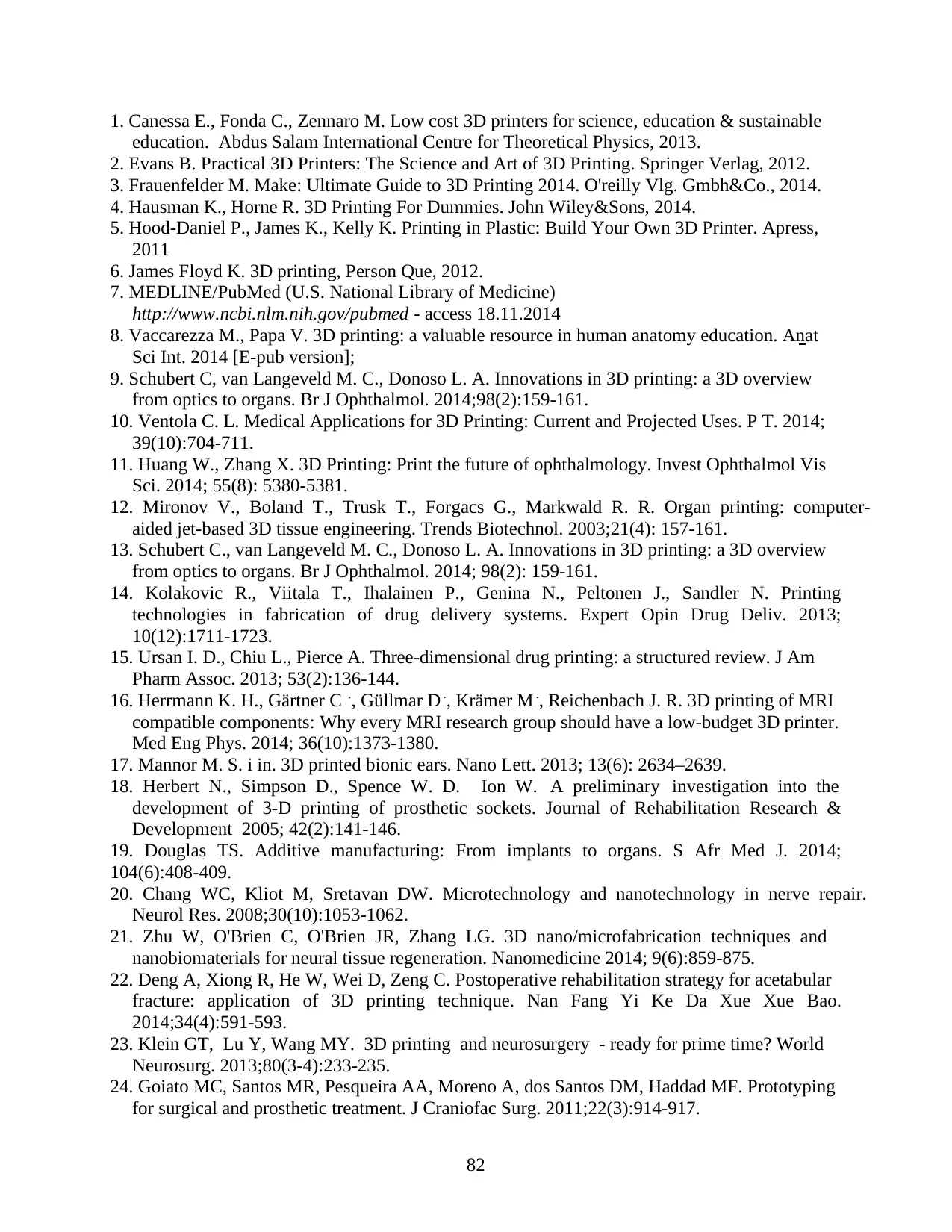
82
1. Canessa E., Fonda C., Zennaro M. Low cost 3D printers for science, education & sustainable
education. Abdus Salam International Centre for Theoretical Physics, 2013.
2. Evans B. Practical 3D Printers: The Science and Art of 3D Printing. Springer Verlag, 2012.
3. Frauenfelder M. Make: Ultimate Guide to 3D Printing 2014. O'reilly Vlg. Gmbh&Co., 2014.
4. Hausman K., Horne R. 3D Printing For Dummies. John Wiley&Sons, 2014.
5. Hood-Daniel P., James K., Kelly K. Printing in Plastic: Build Your Own 3D Printer. Apress,
2011
6. James Floyd K. 3D printing, Person Que, 2012.
7. MEDLINE/PubMed (U.S. National Library of Medicine)
http://www.ncbi.nlm.nih.gov/pubmed - access 18.11.2014
8. Vaccarezza M., Papa V. 3D printing: a valuable resource in human anatomy education. Anat
Sci Int. 2014 [E-pub version];
9. Schubert C, van Langeveld M. C., Donoso L. A. Innovations in 3D printing: a 3D overview
from optics to organs. Br J Ophthalmol. 2014;98(2):159-161.
10. Ventola C. L. Medical Applications for 3D Printing: Current and Projected Uses. P T. 2014;
39(10):704-711.
11. Huang W., Zhang X. 3D Printing: Print the future of ophthalmology. Invest Ophthalmol Vis
Sci. 2014; 55(8): 5380-5381.
12. Mironov V., Boland T., Trusk T., Forgacs G., Markwald R. R. Organ printing: computer-
aided jet-based 3D tissue engineering. Trends Biotechnol. 2003;21(4): 157-161.
13. Schubert C., van Langeveld M. C., Donoso L. A. Innovations in 3D printing: a 3D overview
from optics to organs. Br J Ophthalmol. 2014; 98(2): 159-161.
14. Kolakovic R., Viitala T., Ihalainen P., Genina N., Peltonen J., Sandler N. Printing
technologies in fabrication of drug delivery systems. Expert Opin Drug Deliv. 2013;
10(12):1711-1723.
15. Ursan I. D., Chiu L., Pierce A. Three-dimensional drug printing: a structured review. J Am
Pharm Assoc. 2013; 53(2):136-144.
16. Herrmann K. H., Gärtner C ., Güllmar D ., Krämer M ., Reichenbach J. R. 3D printing of MRI
compatible components: Why every MRI research group should have a low-budget 3D printer.
Med Eng Phys. 2014; 36(10):1373-1380.
17. Mannor M. S. i in. 3D printed bionic ears. Nano Lett. 2013; 13(6): 2634–2639.
18. Herbert N., Simpson D., Spence W. D. Ion W. A preliminary investigation into the
development of 3-D printing of prosthetic sockets. Journal of Rehabilitation Research &
Development 2005; 42(2):141-146.
19. Douglas TS. Additive manufacturing: From implants to organs. S Afr Med J. 2014;
104(6):408-409.
20. Chang WC, Kliot M, Sretavan DW. Microtechnology and nanotechnology in nerve repair.
Neurol Res. 2008;30(10):1053-1062.
21. Zhu W, O'Brien C, O'Brien JR, Zhang LG. 3D nano/microfabrication techniques and
nanobiomaterials for neural tissue regeneration. Nanomedicine 2014; 9(6):859-875.
22. Deng A, Xiong R, He W, Wei D, Zeng C. Postoperative rehabilitation strategy for acetabular
fracture: application of 3D printing technique. Nan Fang Yi Ke Da Xue Xue Bao.
2014;34(4):591-593.
23. Klein GT, Lu Y, Wang MY. 3D printing and neurosurgery - ready for prime time? World
Neurosurg. 2013;80(3-4):233-235.
24. Goiato MC, Santos MR, Pesqueira AA, Moreno A, dos Santos DM, Haddad MF. Prototyping
for surgical and prosthetic treatment. J Craniofac Surg. 2011;22(3):914-917.
1. Canessa E., Fonda C., Zennaro M. Low cost 3D printers for science, education & sustainable
education. Abdus Salam International Centre for Theoretical Physics, 2013.
2. Evans B. Practical 3D Printers: The Science and Art of 3D Printing. Springer Verlag, 2012.
3. Frauenfelder M. Make: Ultimate Guide to 3D Printing 2014. O'reilly Vlg. Gmbh&Co., 2014.
4. Hausman K., Horne R. 3D Printing For Dummies. John Wiley&Sons, 2014.
5. Hood-Daniel P., James K., Kelly K. Printing in Plastic: Build Your Own 3D Printer. Apress,
2011
6. James Floyd K. 3D printing, Person Que, 2012.
7. MEDLINE/PubMed (U.S. National Library of Medicine)
http://www.ncbi.nlm.nih.gov/pubmed - access 18.11.2014
8. Vaccarezza M., Papa V. 3D printing: a valuable resource in human anatomy education. Anat
Sci Int. 2014 [E-pub version];
9. Schubert C, van Langeveld M. C., Donoso L. A. Innovations in 3D printing: a 3D overview
from optics to organs. Br J Ophthalmol. 2014;98(2):159-161.
10. Ventola C. L. Medical Applications for 3D Printing: Current and Projected Uses. P T. 2014;
39(10):704-711.
11. Huang W., Zhang X. 3D Printing: Print the future of ophthalmology. Invest Ophthalmol Vis
Sci. 2014; 55(8): 5380-5381.
12. Mironov V., Boland T., Trusk T., Forgacs G., Markwald R. R. Organ printing: computer-
aided jet-based 3D tissue engineering. Trends Biotechnol. 2003;21(4): 157-161.
13. Schubert C., van Langeveld M. C., Donoso L. A. Innovations in 3D printing: a 3D overview
from optics to organs. Br J Ophthalmol. 2014; 98(2): 159-161.
14. Kolakovic R., Viitala T., Ihalainen P., Genina N., Peltonen J., Sandler N. Printing
technologies in fabrication of drug delivery systems. Expert Opin Drug Deliv. 2013;
10(12):1711-1723.
15. Ursan I. D., Chiu L., Pierce A. Three-dimensional drug printing: a structured review. J Am
Pharm Assoc. 2013; 53(2):136-144.
16. Herrmann K. H., Gärtner C ., Güllmar D ., Krämer M ., Reichenbach J. R. 3D printing of MRI
compatible components: Why every MRI research group should have a low-budget 3D printer.
Med Eng Phys. 2014; 36(10):1373-1380.
17. Mannor M. S. i in. 3D printed bionic ears. Nano Lett. 2013; 13(6): 2634–2639.
18. Herbert N., Simpson D., Spence W. D. Ion W. A preliminary investigation into the
development of 3-D printing of prosthetic sockets. Journal of Rehabilitation Research &
Development 2005; 42(2):141-146.
19. Douglas TS. Additive manufacturing: From implants to organs. S Afr Med J. 2014;
104(6):408-409.
20. Chang WC, Kliot M, Sretavan DW. Microtechnology and nanotechnology in nerve repair.
Neurol Res. 2008;30(10):1053-1062.
21. Zhu W, O'Brien C, O'Brien JR, Zhang LG. 3D nano/microfabrication techniques and
nanobiomaterials for neural tissue regeneration. Nanomedicine 2014; 9(6):859-875.
22. Deng A, Xiong R, He W, Wei D, Zeng C. Postoperative rehabilitation strategy for acetabular
fracture: application of 3D printing technique. Nan Fang Yi Ke Da Xue Xue Bao.
2014;34(4):591-593.
23. Klein GT, Lu Y, Wang MY. 3D printing and neurosurgery - ready for prime time? World
Neurosurg. 2013;80(3-4):233-235.
24. Goiato MC, Santos MR, Pesqueira AA, Moreno A, dos Santos DM, Haddad MF. Prototyping
for surgical and prosthetic treatment. J Craniofac Surg. 2011;22(3):914-917.
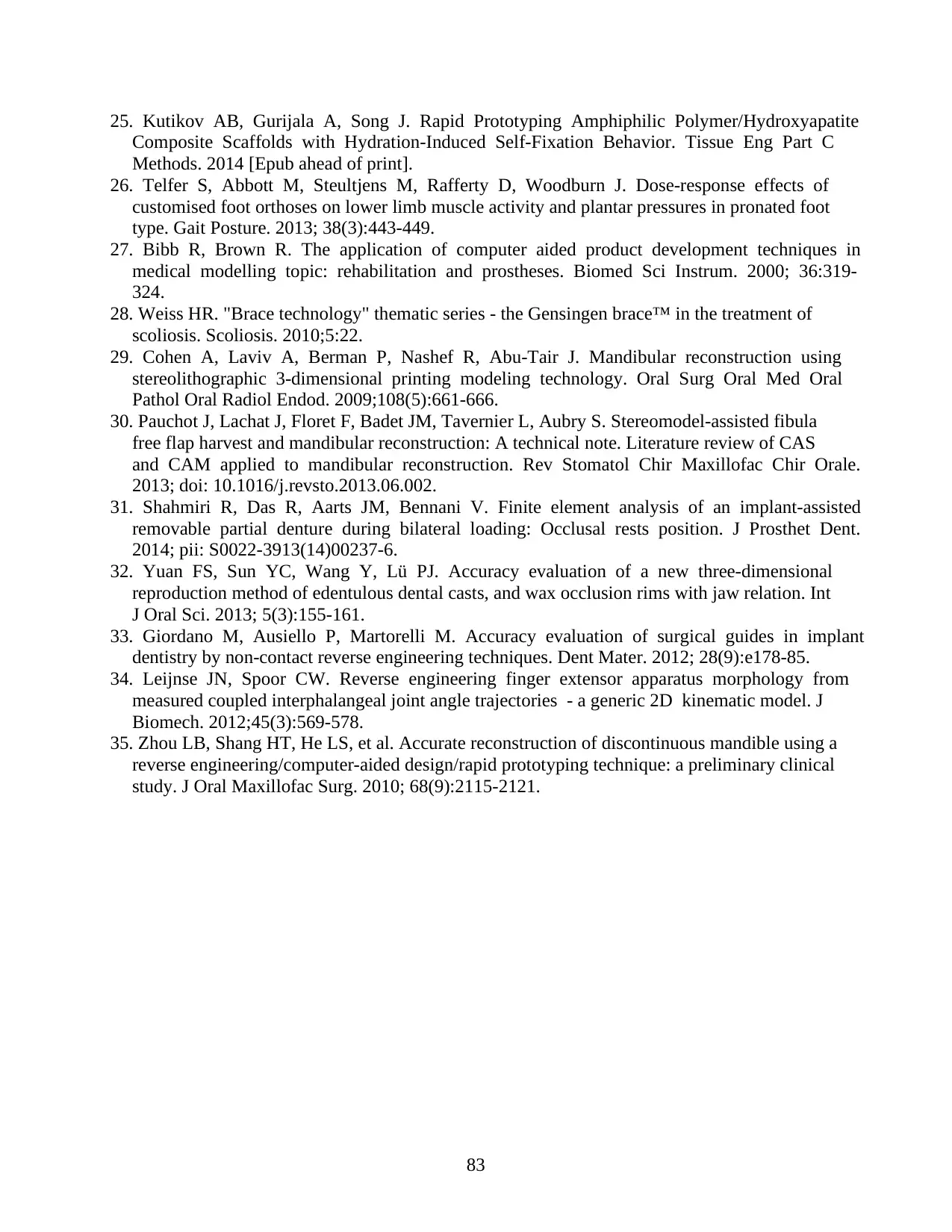
83
25. Kutikov AB, Gurijala A, Song J. Rapid Prototyping Amphiphilic Polymer/Hydroxyapatite
Composite Scaffolds with Hydration-Induced Self-Fixation Behavior. Tissue Eng Part C
Methods. 2014 [Epub ahead of print].
26. Telfer S, Abbott M, Steultjens M, Rafferty D, Woodburn J. Dose-response effects of
customised foot orthoses on lower limb muscle activity and plantar pressures in pronated foot
type. Gait Posture. 2013; 38(3):443-449.
27. Bibb R, Brown R. The application of computer aided product development techniques in
medical modelling topic: rehabilitation and prostheses. Biomed Sci Instrum. 2000; 36:319-
324.
28. Weiss HR. "Brace technology" thematic series - the Gensingen brace™ in the treatment of
scoliosis. Scoliosis. 2010;5:22.
29. Cohen A, Laviv A, Berman P, Nashef R, Abu-Tair J. Mandibular reconstruction using
stereolithographic 3-dimensional printing modeling technology. Oral Surg Oral Med Oral
Pathol Oral Radiol Endod. 2009;108(5):661-666.
30. Pauchot J, Lachat J, Floret F, Badet JM, Tavernier L, Aubry S. Stereomodel-assisted fibula
free flap harvest and mandibular reconstruction: A technical note. Literature review of CAS
and CAM applied to mandibular reconstruction. Rev Stomatol Chir Maxillofac Chir Orale.
2013; doi: 10.1016/j.revsto.2013.06.002.
31. Shahmiri R, Das R, Aarts JM, Bennani V. Finite element analysis of an implant-assisted
removable partial denture during bilateral loading: Occlusal rests position. J Prosthet Dent.
2014; pii: S0022-3913(14)00237-6.
32. Yuan FS, Sun YC, Wang Y, Lü PJ. Accuracy evaluation of a new three-dimensional
reproduction method of edentulous dental casts, and wax occlusion rims with jaw relation. Int
J Oral Sci. 2013; 5(3):155-161.
33. Giordano M, Ausiello P, Martorelli M. Accuracy evaluation of surgical guides in implant
dentistry by non-contact reverse engineering techniques. Dent Mater. 2012; 28(9):e178-85.
34. Leijnse JN, Spoor CW. Reverse engineering finger extensor apparatus morphology from
measured coupled interphalangeal joint angle trajectories - a generic 2D kinematic model. J
Biomech. 2012;45(3):569-578.
35. Zhou LB, Shang HT, He LS, et al. Accurate reconstruction of discontinuous mandible using a
reverse engineering/computer-aided design/rapid prototyping technique: a preliminary clinical
study. J Oral Maxillofac Surg. 2010; 68(9):2115-2121.
25. Kutikov AB, Gurijala A, Song J. Rapid Prototyping Amphiphilic Polymer/Hydroxyapatite
Composite Scaffolds with Hydration-Induced Self-Fixation Behavior. Tissue Eng Part C
Methods. 2014 [Epub ahead of print].
26. Telfer S, Abbott M, Steultjens M, Rafferty D, Woodburn J. Dose-response effects of
customised foot orthoses on lower limb muscle activity and plantar pressures in pronated foot
type. Gait Posture. 2013; 38(3):443-449.
27. Bibb R, Brown R. The application of computer aided product development techniques in
medical modelling topic: rehabilitation and prostheses. Biomed Sci Instrum. 2000; 36:319-
324.
28. Weiss HR. "Brace technology" thematic series - the Gensingen brace™ in the treatment of
scoliosis. Scoliosis. 2010;5:22.
29. Cohen A, Laviv A, Berman P, Nashef R, Abu-Tair J. Mandibular reconstruction using
stereolithographic 3-dimensional printing modeling technology. Oral Surg Oral Med Oral
Pathol Oral Radiol Endod. 2009;108(5):661-666.
30. Pauchot J, Lachat J, Floret F, Badet JM, Tavernier L, Aubry S. Stereomodel-assisted fibula
free flap harvest and mandibular reconstruction: A technical note. Literature review of CAS
and CAM applied to mandibular reconstruction. Rev Stomatol Chir Maxillofac Chir Orale.
2013; doi: 10.1016/j.revsto.2013.06.002.
31. Shahmiri R, Das R, Aarts JM, Bennani V. Finite element analysis of an implant-assisted
removable partial denture during bilateral loading: Occlusal rests position. J Prosthet Dent.
2014; pii: S0022-3913(14)00237-6.
32. Yuan FS, Sun YC, Wang Y, Lü PJ. Accuracy evaluation of a new three-dimensional
reproduction method of edentulous dental casts, and wax occlusion rims with jaw relation. Int
J Oral Sci. 2013; 5(3):155-161.
33. Giordano M, Ausiello P, Martorelli M. Accuracy evaluation of surgical guides in implant
dentistry by non-contact reverse engineering techniques. Dent Mater. 2012; 28(9):e178-85.
34. Leijnse JN, Spoor CW. Reverse engineering finger extensor apparatus morphology from
measured coupled interphalangeal joint angle trajectories - a generic 2D kinematic model. J
Biomech. 2012;45(3):569-578.
35. Zhou LB, Shang HT, He LS, et al. Accurate reconstruction of discontinuous mandible using a
reverse engineering/computer-aided design/rapid prototyping technique: a preliminary clinical
study. J Oral Maxillofac Surg. 2010; 68(9):2115-2121.
1 out of 6
Your All-in-One AI-Powered Toolkit for Academic Success.
+13062052269
info@desklib.com
Available 24*7 on WhatsApp / Email
![[object Object]](/_next/static/media/star-bottom.7253800d.svg)
Unlock your academic potential
© 2024 | Zucol Services PVT LTD | All rights reserved.